Coca and Rumipamba – July 30
We spent one night in Coca, at the Hotel Auca, before embarking out into the Indigenous villages of Cofan Dureno and San Pablo in the Amazon.
“Auca” is apparently a racist name for the Huaorani. It’s another tribe’s word for “savage”, and the white men who built the hotel were so amused by the fact that another tribe referred to the Huaorani that way that they gave the hotel that name.
We returned to the Quechua community of Rumipamba for a second day to see the ongoing clean up effort behind Guillermo Grefa’s house (read about our first day in Rumipamba here). The word “tragic” leaps to mind immediately—after two years of cleanup, they’ve still only cleaned about 40 square meters of land.
Even more tragic, here’s how the cleanup works: Two workers put on rubber waders, gas masks, and gloves, walk out into the water, and use high-pressure hoses to stir up the mud at the bottom of the pond. This causes the oil that has settled there to rise back to the surface. Then workers on the shore skim the oil off the top and drop it in buckets which then get emptied into barrels, which PetroEcuador eventually comes and hauls away. None of the workers on the shore wear gas masks.
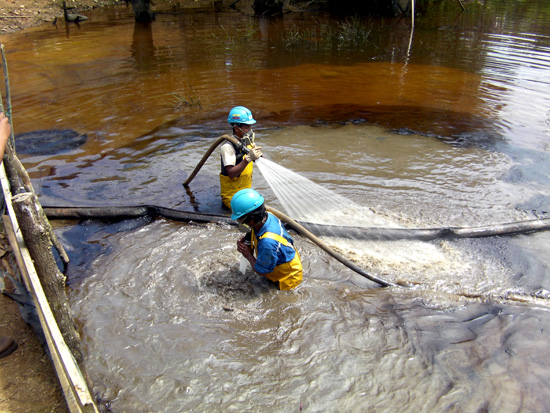
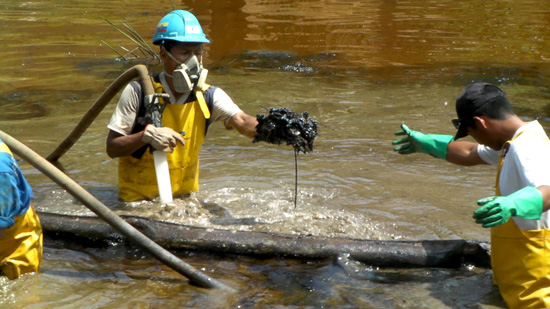
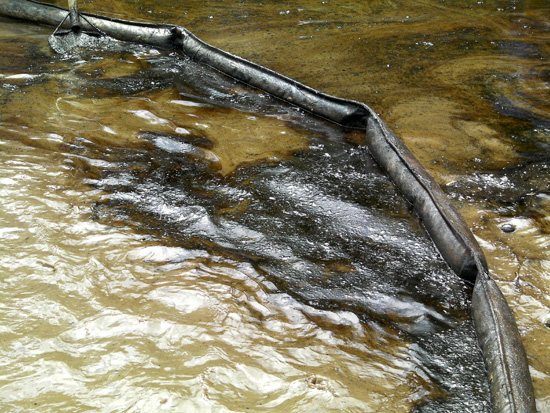
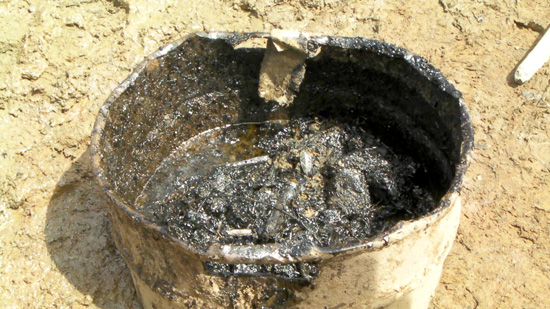
These Quechua people may be cleaning their land—slowly if not altogether surely—but it’s hard to imagine that they’re making themselves any healthier in the process.
After Guillermo’s house, we toured the community water system built by the local Orellana municipal government, which isn’t functioning properly. Some people still get water from it, but they don’t have the chemicals to treat it properly—those ran out a few months after the system was built, and the government doesn’t provide the community with any more. The system uses gravity to get the water out to the community, but due to poor design it doesn’t reach everyone. Guillermo, for instance, doesn’t even live that far from the system, but he only gets a little bit of water from it, not nearly enough for him and his family during the dry summer months.
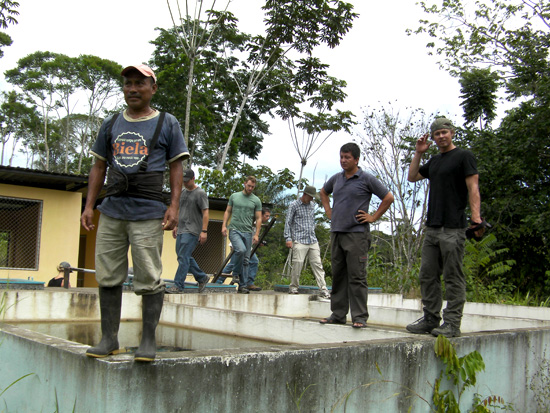
Because the community water system no longer provides clean water to most people, many families are drinking from wells they’ve drilled themselves, which have never been tested for contamination, or from surface water sources known to be contaminated by oil. The community members lack the expertise and the resources to fix the community water system, and perhaps were never terribly motivated to fix it because it never reached all the houses in the community anyway. Still, the Engineers Without Borders team (from the San Jose State University chapter) felt that fixing the community water system might be a good part of the solution to the lack of clean water, along with rainwater catchment systems.
We climbed to the top of the water towers. It was a nice view, unless you were facing in the direction where you could see smoke from gas flares in the distance, or the drilling rig soaring above the forest canopy.
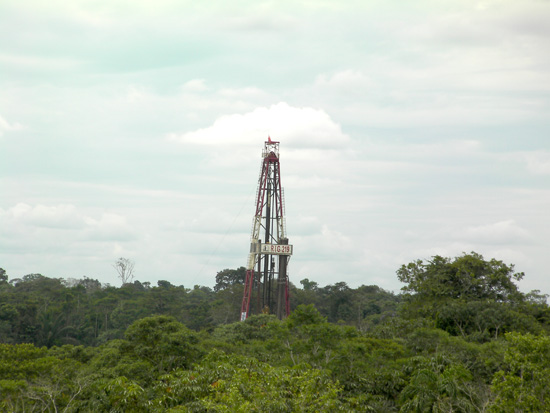
The day before, Guillermo had told us that his rainwater catchment system (not a ClearWater system, but built by a previous effort to bring rainwater catchment systems to communities suffering the impacts of Texaco’s oil pollution), was mostly working well, except in summer months when there wasn’t enough rain to keep it filled. Also, even though the system was only put in a few years ago and has several years of life left, the wooden framework it was built on is already starting to succumb to the harsh rainforest environment, pretty much melting away under the relentless assault of rain, humidity, and heat. The community water system might help meet this summer shortfall, but there’s still the problem of the wooden structure’s short lifespan.
The EWB team inquired about the availability of concrete, which could be used for the structures instead of wood, and also said that a “first flush” system would be needed, since there was gas flaring in the area and they were concerned that particulate matter could be settling onto the house’s roof. A first flush system, they explained, would cause the first bit of rainwater passing across the roof not to go into the catchment system’s storage tank, thereby flushing any toxic particulate matter off the roof before collection of rainwater begins.
After Rumpamba, we did one of the famous “Toxitours” as led by Donald Moncayo. When I first met Donald at the airport in Coca, I told him “He visto a muchos photos de ti”—“I’ve seen many photos of you.” When he reacted with some surprise to this, I told him, “Pues, tu eres famoso!”
Donald got a good laugh out of being told he was famous—and, as I would discover, laughter is something that comes very easily to Donald and many of the other residents of the oil-ravaged Ecuadorean Amazon.
But it was actually true: I have seen many pictures of Donald, because he is somewhat famous. The number of journalists, researchers, scientists, and other folks who have taken a Toxitour probably cannot be counted. He has been written about in numerous publications, and photographed and videotaped, I’d guess, as much as any celebrity.
Much like when I first witnessed the oil pollution at Guillermo Grefa’s house, it was an entirely new, authentically moving experience to see the Toxitour for myself. Chevron lawyers have claimed that Donald goes out the night before a Toxitour and buries the oil he then digs up for his audience. This is absurd, of course. Donald took us out by the Sacha Sur separation station within the Sacha oil field. Right across the street is an old drill site, and Donald only had to dig down a few feet with his augur before the mud took on a distinct petroleum odor. When he hit a rock or something else that wouldn’t allow him to go any further, he moved over a couple feet and again was pulling up petroleum-smelling mud after just a few feet.
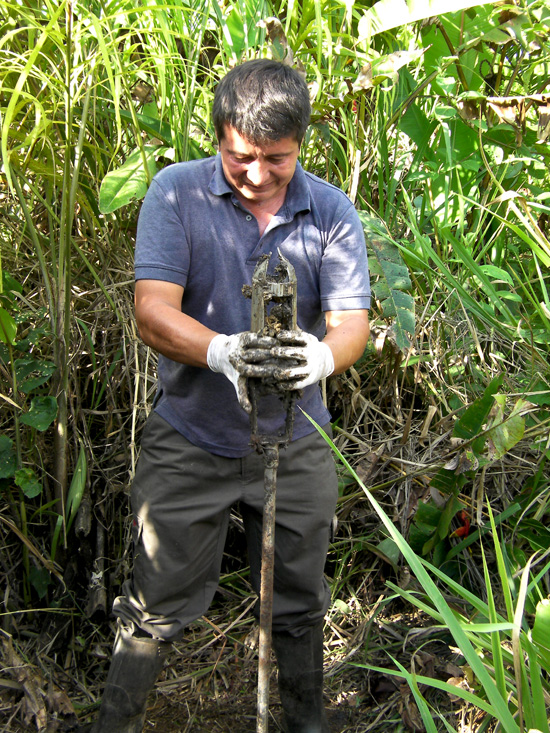
Donald then took us down a short jungle trail to the bank of a small creek. There was oil plainly visible on the top of the water. Donald picked up a shovelful of mud from the creek’s bank and it was all oily black. He told us that this was one of the creeks that Texaco deliberately dumped billions of gallons of toxic oil waste into, and that he had had “the pleasure” of trekking some 800 meters down the creek to witness the extent of the damage.
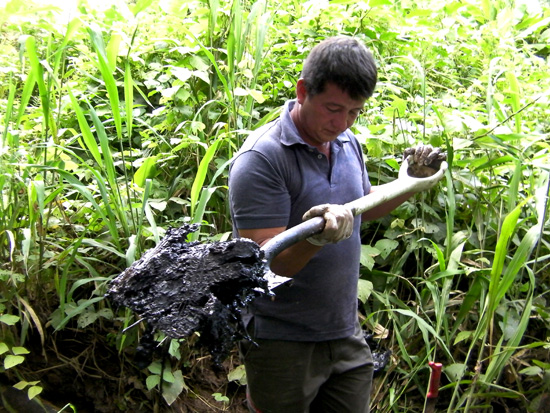
While walking back to our van, we noticed some poles sticking out of the ground in what was otherwise jungle. Donald told us that those used to be the stilts that Maria Garrafolo’s house sat on. You might have seen her in the movie Crude—she’s the woman taking her teenage daughter into the city to be treated for cancer. It’s probably no wonder her daughter had such a severe illness at such a young age—she literally grew up in the flickering shadows cast by the three gas flares at the separation station next door. PetroEcuador has since moved Maria Garrafolo and her daughter, and the jungle has reclaimed the site her house once stood on.
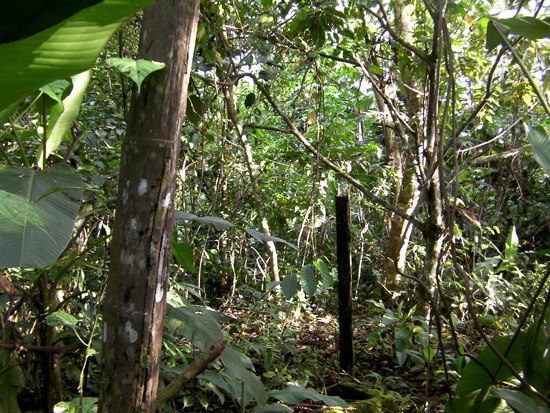
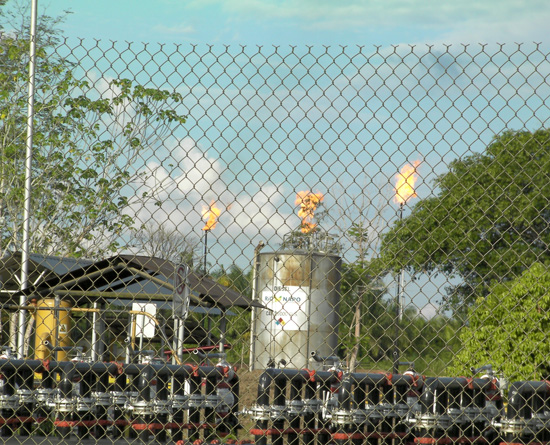
So, now we’d seen the problem: extensive oil contamination and insufficient supply of clean drinking water. We still had a little bit of Toxitour left, but we would soon see the solution: ClearWater.